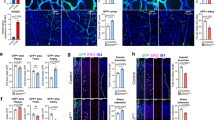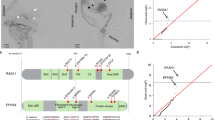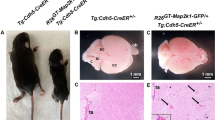Abstract
Vascular malformations cause discomfort and pain in children and are often associated with skeletal hypertrophy. Their molecular basis is poorly understood. Ephrin ligands and Eph receptor tyrosine kinases are involved in embryonic vascular development. In mice, some ephrin/Eph family members show a complementary expression pattern in blood vessels, with ephrinB2 being expressed on arterial and EphB4 on venous endothelium. Targeted deletions of the genes reveal their essential roles for conduit vessel development in mice, suggesting similar functions during human vascular development and deregulation in vascular malformations. Here, we have defined the expression patterns of human ephrinB2, EphB4, and EphB2 in normal vessels of neonates (i.e. umbilici) and adults and compared them with those in congenital venous malformations. In adults, normal vessels of the skin, muscle, and legs express ephrinB2 and EphB2 on arterial endothelial cells (ECs), whereas EphB4 is found in arteries and veins. In the umbilicus, EphB2 is a specific marker of arterial ECs, whereas ephrinB2 is additionally expressed in venous ECs, suggesting an arterial function of the veins. In venous malformations, the expression of EphB4 is not altered, but both ephrinB2 and EphB2 are ectopically expressed in venous ECs. This may reflect a nonphysiologic arterialization of malformed veins. Our study shows that the arterial markers ephrin B2 and EphB2 are expressed in a subset of veins, and it remains to be studied whether this is cause or consequence of an altered vascular identity.
Similar content being viewed by others
Log in or create a free account to read this content
Gain free access to this article, as well as selected content from this journal and more on nature.com
or
Abbreviations
- EC:
-
endothelial cell
- SAM:
-
sterile α motif
- α-SMA:
-
α-smooth muscle actin
- SMC:
-
smooth muscle cell
References
Coffin JD, Poole TJ 1988 Embryonic vascular development: immunohistochemical identification of the origin and subsequent morphogenesis of the major vessel primordia in quail embryos. Development 102: 735–748
Risau W 1997 Mechanisms of angiogenesis. Nature 386: 671–674
Risau W, Flamme I 1995 Vasculogenesis. Annu Rev Cell Dev Biol 11: 73–91
Sherer GK 1991 Vasculogenic mechanisms and epithelio-mesenchymal specificity in endodermal organs. Issues Biomed 14: 37–57
Wilting J, Brand-Saberi B, Kurz H, Christ B 1995 Development of the embryonic vascular system. Cell Mol Biol Res 41: 219–232
Folkman J 1995 Angiogenesis in cancer, vascular, rheumatoid and other disease. Nat Med 1: 27–31
Hanahan D, Folkman J 1996 Patterns and emerging mechanisms of the angiogenic switch during tumorigenesis. Cell 86: 353–364
Gale NW, Yancopoulos GD 1999 Growth factors acting via endothelial cell-specific receptor tyrosine kinases: VEGFs, angiopoietins, and ephrins in vascular development. Genes Dev 13: 1055–1066
Adams RH 2002 Vascular patterning by Eph receptor tyrosine kinases and ephrins. Semin Cell Dev Biol 13: 55–60
Kullander K, Klein R 2002 Mechanisms and functions of Eph and ephrin signalling. Nat Rev Mol Cell Biol 3: 475–486
Palmer A, Klein R 2003 Multiple roles of ephrins in morphogenesis, neuronal networking, and brain function. Genes Dev 17: 1429–1450
Wang HU, Chen ZF, Anderson DJ 1998 Molecular distinction and angiogenic interaction between embryonic arteries and veins revealed by ephrin-B2 and its receptor Eph-B4. Cell 93: 741–753
Adams RH, Wilkinson GA, Weiss C, Diella F, Gale NW, Deutsch U, Risau W, Klein R 1999 Roles of ephrinB ligands and EphB receptors in cardiovascular development: demarcation of arterial/venous domains, vascular morphogenesis, and sprouting angiogenesis. Genes Dev 13: 295–306
Cheng N, Brantley DM, Chen J 2002 The ephrins and Eph receptors in angiogenesis. Cytokine Growth Factor Rev 13: 75–85
Nakamoto M, Bergemann AD 2002 Diverse roles for the Eph family of receptor tyrosine kinases in carcinogenesis. Microsc Res Tech 59: 58–67
Fishman SJ, Mulliken JB 1993 Hemangiomas and vascular malformations of infancy and childhood. Pediatr Clin North Am 40: 1177–1200
Landthaler M, Vogt T, Hohenleutner U 2002 Clinical and histological classification of benign vascular malformations and tumors of the skin. In: Landthaler M, Hohenleutner U, Vogt T (eds) Benign Vascular Malformations and Tumors of the Skin. Blackwell Verlag, Berlin, pp 31–43
Schlingemann RO, Dingjan GM, Emeis JJ, Blok J, Warnaar SO, Ruiter DJ 1985 Monoclonal antibody PAL-E specific for endothelium. Lab Invest 52: 71–76
Grunwald IC, Korte M, Wolfer D, Wilkinson GA, Unsicker K, Lipp HP, Bonhoeffer T, Klein R 2001 Kinase-independent requirement of EphB2 receptors in hippocampal synaptic plasticity. Neuron 32: 1027–1040
Wilting J, Papoutsi M, Christ B, Nicolaides KH, von Kaisenberg CS, Borges J, Stark GB, Alitalo K, Tomarev SI, Niemeyer C, Rossler J 2002 The transcription factor Prox1 is a marker for lymphatic endothelial cells in normal and diseased human tissues. FASEB J 16: 1271–1273
Adams RH, Klein R 2000 Eph receptors and ephrin ligands. Essential mediators of vascular development. Trends Cardiovasc Med 10: 183–188
Othman-Hassan K, Patel K, Papoutsi M, Rodriguez-Niedenfür M, Christ B, Wilting J 2001 Arterial identity of endothelial cells is controlled by local cues. Dev Biol 237: 398–409
Schiebler TH, Schmidt W, Zilles K 1999 Anatomie. Springer-Verlag, Berlin, pp 126–127
Belov S 1990 Classification of congenital vascular defects. Int Angiol 9: 141–146
Belov S 1993 Anatomopathological classification of congenital vascular defects. Semin Vasc Surg 6: 219–224
Leu HJ 1989 Pathoanatomy of congenital vascular malformations. Period Angiol 16: 37–45
Leu HJ 1990 Pathomorphology of vascular malformations. Analysis of 310 cases. Int Angiol 9: 147–154
Davis S, Gale NW, Aldrich TH, Maisonpierre PC, Lhotak V, Pawson T, Goldfarb M, Yancopoulos GD 1994 Ligands for EPH-related receptor tyrosine kinases that require membrane attachment or clustering for activity. Science 266: 816–819
Brückner K, Klein R 1998 Signalling by Eph receptors and their ephrin ligands. Curr Opin Neurobiol 8: 375–382
Becker N, Seitanidou T, Murphy P, Mattei MG, Topilko P, Nieto MA, Wilkinson DG, Charnay P, Gilardi-Hebenstreit P 1994 Several receptor tyrosine kinase genes of the Eph family are segmentally expressed in the developing hindbrain. Mech Dev 47: 3–17
Smith A, Robinson F, Patel K, Wilkinson DG 1997 The EphA4 and EphB1 receptor tyrosine kinases and ephrin-B2 ligand regulate targeted migration of branchial neural crest cells. Curr Biol 1: 561–570
Gao PP, Zhang JH, Yokoyama M, Racey B, Dreyfus CF, Black IB, Zhou R 1996 Regulation of topographic projection in the brain: Elf-1 in the hippocamposeptal system. Proc Natl Acad Sci USA 93: 11161–11166
Drescher U, Kremoser C, Handwerker C, Loschinger J, Noda M, Bonhoeffer F 1995 In vitro guidance of retinal ganglion cell axons by RAGS, a 25kDa tectal protein related to the ligands for Eph receptor tyrosine kinases. Cell 82: 359–370
Stockdale FE, Nikovits W Jr, Christ B 2000 Molecular and cellular biology of avian somite development. Dev Dyn 219: 304–321
Laberge-le Couteulx S, Jung HH, Labauge P, Houtteville JP, Lescoat C, Cecillon M, Marechal E, Joutel A, Bach JF, Tournier-Lasserve E 1999 Truncating mutations in CCM1, encoding KRIT1, cause hereditary cavernous angiomas. Nat Genet 23: 189–193
Serebriiskii I, Estojak J, Sonoda G, Testa JR, Golemis EA 1997 Association of Krev-1/rap1a with Krit1, a novel ankyrin repeat-containing protein encoded by a gene mapping to 7q21–22. Oncogene 15: 1043–1049
Vikkula M, Boon LM, Carraway KL 3rd, Calvert JT, Diamonti AJ, Goumnerov B, Pasyk KA, Marchuk DA, Warman ML, Cantley LC, Mulliken JB, Olsen BR 1996 Vascular dysmorphogenesis caused by an activating mutation in the receptor tyrosine kinase TIE2. Cell 87: 1181–1190
Brouillard P, Olsen BR, Vikkula M 2000 High-resolution physical and transcript map of the locus for venous malformations with glomus cells (VMGLOM) on chromosome 1p21-p22. Genomics 67: 96–101
Gerety SS, Anderson DJ 2002 Cardiovascular ephrinB2 function is essential for embryonic angiogenesis. Development 129: 1397–1410
Brantley DM, Cheng N, Thompson EJ, Lin Q, Brekken RA, Thorpe PE, Muraoka RS, Cerretti DP, Pozzi A, Jackson D, Lin C, Chen J 2002 Soluble Eph A receptors inhibit tumor angiogenesis and progression in vivo. Oncogene 21: 7011–7026
Gerety SS, Wang HU, Chen ZF, Anderson DJ 1999 Symmetrical mutant phenotypes of the receptor EphB4 and its specific transmembrane ligand ephrin-B2 in cardiovascular development. Mol Cell 4: 403–414
Henkemeyer M, Orioli D, Henderson JT, Saxton TM, Roder J, Pawson T, Klein R 1996 Nuk controls pathfinding of commissural axons in the mammalian central nervous system. Cell 86: 35–46
Pullinger DB, Florey HW 1937 Proliferation of lymphatics in inflammation. J Pathol Bacteriol 45: 157–170
Fuller T, Korff T, Kilian A, Dandekar G, Augustin HG 2003 Forward EphB4 signaling in endothelial cells controls cellular repulsion and segregation from ephrinB2 positive cells. J Cell Sci 116: 2461–2470
Zwolak RM, Adams MC, Clowes AW 1987 Kinetics of vein graft hyperplasia: association with tangential stress. J Vasc Surg 5: 126–136
Author information
Authors and Affiliations
Corresponding author
Additional information
This study was supported by grant DI 832/1-1 from the Deutsche Forschungsgemeinschaft.
Rights and permissions
About this article
Cite this article
Diehl, S., Bruno, R., Wilkinson, G. et al. Altered Expression Patterns of EphrinB2 and EphB2 in Human Umbilical Vessels and Congenital Venous Malformations. Pediatr Res 57, 537–544 (2005). https://doi.org/10.1203/01.PDR.0000155761.70710.C4
Received:
Accepted:
Issue date:
DOI: https://doi.org/10.1203/01.PDR.0000155761.70710.C4
This article is cited by
-
MicroRNA-9 rescues hyperglycemia-induced endothelial cell dysfunction and promotes arteriogenesis through downregulating Notch1 signaling
Molecular and Cellular Biochemistry (2021)
-
Functional characterization of iPSC-derived arterial- and venous-like endothelial cells
Scientific Reports (2019)
-
Arterialization and anomalous vein wall remodeling in varicose veins is associated with upregulated FoxC2-Dll4 pathway
Laboratory Investigation (2016)
-
Activation of multiple angiogenic signaling pathways in hemangiopericytoma
Brain Tumor Pathology (2016)
-
EphrinB2 sharpens lateral motor column division in the developing spinal cord
Neural Development (2015)



